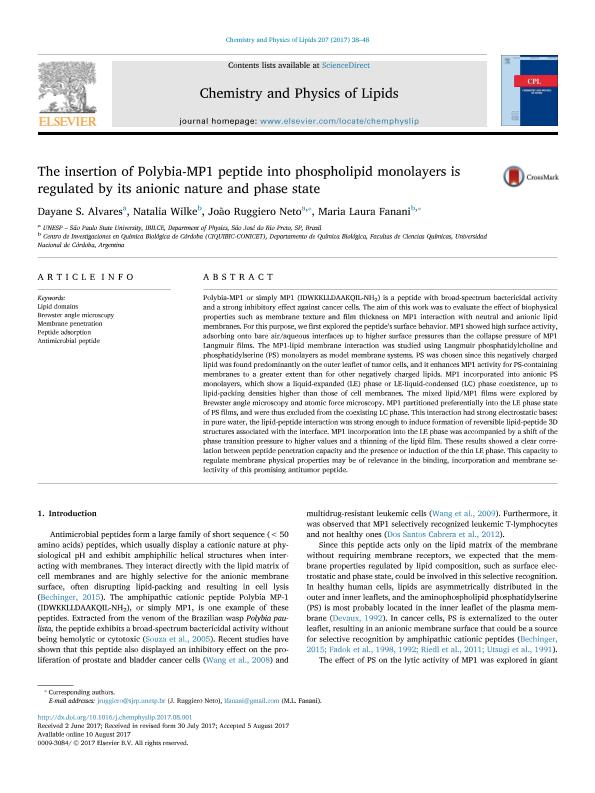Artículo
The insertion of Polybia-MP1 peptide into phospholipid monolayers is regulated by its anionic nature and phase state
Fecha de publicación:
10/2017
Editorial:
Elsevier Ireland
Revista:
Chemistry And Physics Of Lipids
ISSN:
0009-3084
Idioma:
Inglés
Tipo de recurso:
Artículo publicado
Clasificación temática:
Resumen
Polybia-MP1 or simply MP1 (IDWKKLLDAAKQIL-NH2) is a peptide with broad-spectrum bactericidal activity and a strong inhibitory effect against cancer cells. The aim of this work was to evaluate the effect of biophysical properties such as membrane texture and film thickness on MP1 interaction with neutral and anionic lipid membranes. For this purpose, we first explored the peptide's surface behavior. MP1 showed high surface activity, adsorbing onto bare air/aqueous interfaces up to higher surface pressures than the collapse pressure of MP1 Langmuir films. The MP1-lipid membrane interaction was studied using Langmuir phosphatidylcholine and phosphatidylserine (PS) monolayers as model membrane systems. PS was chosen since this negatively charged lipid was found predominantly on the outer leaflet of tumor cells, and it enhances MP1 activity for PS-containing membranes to a greater extent than for other negatively charged lipids. MP1 incorporated into anionic PS monolayers, which show a liquid-expanded (LE) phase or LE-liquid-condensed (LC) phase coexistence, up to lipid-packing densities higher than those of cell membranes. The mixed lipid/MP1 films were explored by Brewster angle microscopy and atomic force microscopy. MP1 partitioned preferentially into the LE phase state of PS films, and were thus excluded from the coexisting LC phase. This interaction had strong electrostatic bases: in pure water, the lipid-peptide interaction was strong enough to induce formation of reversible lipid-peptide 3D structures associated with the interface. MP1 incorporation into the LE phase was accompanied by a shift of the phase transition pressure to higher values and a thinning of the lipid film. These results showed a clear correlation between peptide penetration capacity and the presence or induction of the thin LE phase. This capacity to regulate membrane physical properties may be of relevance in the binding, incorporation and membrane selectivity of this promising antitumor peptide.
Archivos asociados
Licencia
Identificadores
Colecciones
Articulos(CIQUIBIC)
Articulos de CENTRO DE INVEST.EN QCA.BIOL.DE CORDOBA (P)
Articulos de CENTRO DE INVEST.EN QCA.BIOL.DE CORDOBA (P)
Citación
Alvares, Dayane S.; Wilke, Natalia; Ruggiero Neto, João; Fanani, Maria Laura; The insertion of Polybia-MP1 peptide into phospholipid monolayers is regulated by its anionic nature and phase state; Elsevier Ireland; Chemistry And Physics Of Lipids; 207; 10-2017; 38-48
Compartir
Altmétricas




